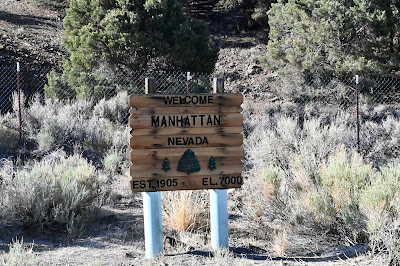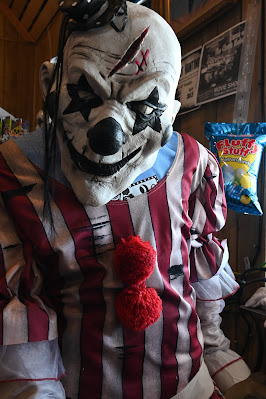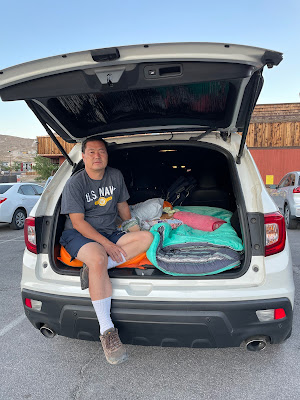Departing Tonopah, we drove north through Toiyabe National Forest (pretty much a desert) to explore two more ghost towns. The first was the Manhattan Ghost Town. Driving on the main street, we only saw one car and the town seemed deserted.
Originally referred to Manhattan Gulch in the 1860s, by 1905, a prospector by the name of Frank Humphrey uncovered gold, prompting several hundred people to follow suit. Within a year, the population soared to 4,000 and a business popped in downtown.
The mining continued to boom in 1909 to 1940s, totaling in $10 million in production before it ceased in 1947. Gold is still very prevalent in this region on a small scale. Today, around 125 people continue to reside in Manhattan. A pleasant visit seeing the Manhattan Bar & Motel, a deer, old buildings, and the Manhattan church, prominently positioned on the hillside overlooking the former business district.
 |
| The Manhattan Bar |
 |
| Manhattan Motel |
 |
| A Deer |
 |
| Main Street - Old Buildings |
 |
| The Manhattan Church |
A bit of history about the Belmont's Stolen Church. Back when the mining boom was busting in Manhattan, its soon-to-be-former residents packed up and left Belmont (nearby town) to seek fortune in Manhattan, but that packing up wasn't limited to personal belongings. One night in 1908, the new Manhattanites went back and stole that church, rolling it on timbers more than 17 miles to its current location.
 |
| Welcome Belmont, NV |
On to Belmont to see the strangely similar house of worship. Belmont sprung to life after a massive silver discovery made in 1865 - just one year after Nevada became a State. Copper, lead and antimony were also discovered, drawing thousands of eager prospectors. The town reach its peak population in 1870s, boasting 2,000 people, four stores, two saloons, five restaurants, a post office, assay office, bank, school, two newspapers, and one impressive courthouse.
 |
| Main Street Buildings |
 |
| The old timers referred to this house as the doctor's house |
During that time, important city and county records were kept in a variety of odd and often unsecured places. The city fathers recognized the need for a central civic building - a place that could house all the government offices, including a jail, and a courtroom. In 1875, a movement was underway to raise funds to build the Belmont Courthouse with the state granting $3,400. Bonds were passed and additional funds were raised, and a building site was purchased from the Belmont Mining Company just west of Main Street.
 |
| Belmont Courthouse |
The courthouse is an early Italianate style that called for red-brick construction on a stone foundation with two floors.
 |
| Courthouse and a Jail |
By 1887, the rich ore deposits of Belmont began to play out. Several mines closed and the town experienced a rapid decline in population. By 1900, there were fewer than 100 voters registered there. In 1905, Belmont had its last court case and the county seat was moved to Tonopah where it remains today. When we visited the courthouse it was locked shut. In reading about the history of this courthouse, when it was open and abandoned for many years it experienced the ravages of time, vandals, extreme weather, and seismic disturbances. Apparently, during this time it was common for locals and visitors to leave graffiti on the interior walls in the form of poetry, names, and drawings. The most notable of these graffiti artists may have been the notorious Charles Manson who masterminded a string of California murders in the 1950s. He and his followers are believed to have visited the courthouse. Carved into a door frame on the first floor is the haunting inscription, "Charlie Manson + family 1969" with a peace symbol drawn in the O in Manson.
 |
| Source: Photo from Travel Nevada |
Historian Terry Terras has studied the building's myriad graffiti and has a favorite. It is a poem written to a young lady by a soldier being deployed during WWII.
"When you and I our love must part/may it cause pain in both our hearts/I to some foreign land will go/sleep cold in death as others do/All this and more I have to say but/night calls and I must away/With these lines/you will a hidden question find."
It took a while for the historian to realized that the poem had a hidden code. Using just first word of each sentence, it reads: "When may I sleep all night with you?" Pretty cool!
Here's something interesting that Nan took a photo of, The Ten Commandments, Cowboy Style;
Belmont Church, 2001. This structure is a replica of the Catholic Church that was moved from Belmont to Manhattan in 1906.
 |
| Belmont Church |
Belmont Cemetery 1869 - Present, is located in a beautiful setting of pine, juniper and sagebrush beneath the base of Cemetery Hill. The first occupants were most likely interred in the winter of 1869. As we walked through the cemetery we saw family plots of many of the people who came to Belmont to settle and establish businesses in and around the area. WE also saw a number of small graves, I guess the infant mortality rate was quite high due to childhood illnesses and epidemics.
In true boomtown fashion, the mine dried up and shut down, and the folks living here moved on to the next big boom.
Old smoke stack at combination mill ruins.
This mill was a forty stamp mill built in 1867 and by September of 1868 was closed. There were two large smoke stacks intended to carry the smoke and pollutants (sulfur, etc.) down wind and away from the community of East Belmont.
The sulfide silver were crushed, roasted, salt added and mixed with mercury to extract silver. In July 1878, the mill was remodeled and was running until May 1879.
Belmont is a place that satisfied our old American West Ghost town hankering. It was truly an adventure!Thanks for reading, safe travels!



















































